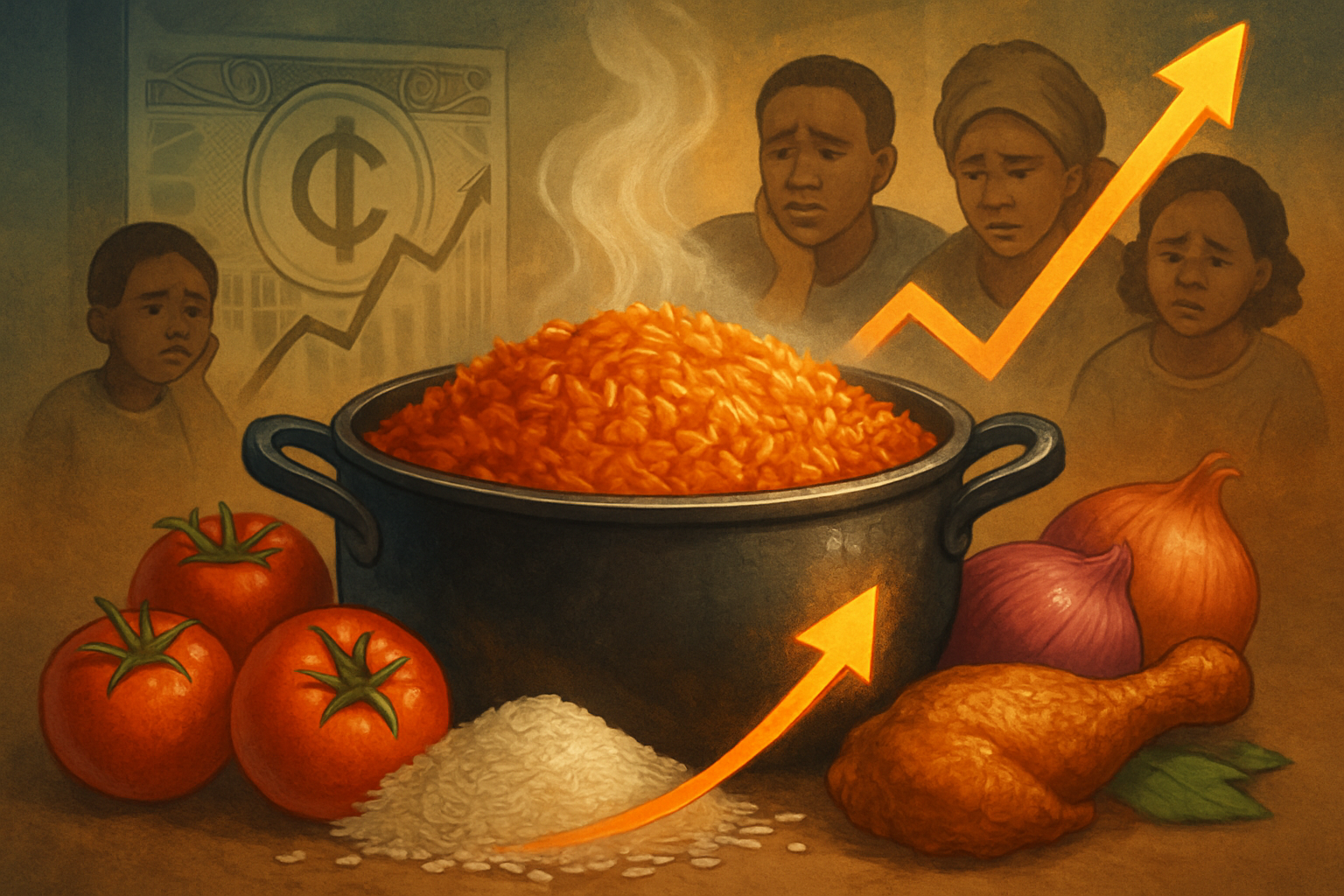
Accra, Ghana – October 21, 2025 – For the first time in three months, the cost of preparing Ghana's beloved Jollof rice has risen, presenting a perplexing challenge to households despite the nation's currency demonstrating remarkable strength against major international currencies. This unexpected uptick, revealed by the latest Jollof Index, highlights deep-seated structural issues within the food sector that even a robust cedi cannot entirely mitigate, casting a shadow over the economic stability of many Ghanaian families.
The average cost to prepare a pot of Jollof for a family of five increased by 2.56% in September 2025, jumping from GH¢420 in June to GH¢430.8. This modest but significant rise comes at a time when the Ghanaian Cedi has been lauded as one of Africa's strongest currencies, appreciating steadily against the US dollar. The paradox underscores a critical disconnect: while macroeconomic policies have successfully stabilized the currency and reined in headline inflation, the everyday cost of essential food items continues to burden consumers, exposing the limitations of monetary policy alone in addressing food inflation.
Unpacking the Persistent Pressure on Ghana's Food Basket
The recent surge in Jollof costs, despite a strengthening currency, is a symptom of multifaceted challenges within Ghana's food supply chain. A primary driver remains the pervasive issue of domestic supply disruptions and production challenges. High transportation costs, a persistent problem in Ghana, significantly inflate retail prices as produce moves from farms to markets. For instance, month-on-month inflation for transport saw a substantial jump of 10.6% in May 2024, far outpacing the national average.
Compounding this are low agricultural production levels, exacerbated by illegal mining activities ("galamsey") that destroy vast tracts of arable land, and the increasing conversion of farmland for real estate development. The agricultural sector also grapples with inadequate infrastructure, limited access to modern farming techniques, poor quality seeds, insufficient fertilizer supply, lack of mechanization, and non-availability of agro-credit for smallholder farmers. These systemic issues collectively constrain supply and push prices upward.
Furthermore, global commodity price swings continue to exert pressure. Despite a strong cedi, Ghana remains vulnerable to international price fluctuations for key imported ingredients like wheat and fuel, which have seen surges due to global supply chain disruptions and geopolitical tensions. Ghana's substantial over-reliance on imported food products, such as its annual import of over $400 million worth of tomatoes from Burkina Faso, further exposes the economy to external price volatilities. The phenomenon of price stickiness also plays a role, where traders do not always readily reduce prices even when import costs theoretically decrease, maintaining higher margins. Regional disparities, too, are stark, with areas like the North East region recording a severe 20.1% inflation rate in September 2025, more than double the national average, highlighting uneven market access and supply chain efficiency.
The Jollof Index, developed by SBM Intelligence in 2015, has been a crucial tool in tracking these costs. The recent increase follows a period where Ghana's food inflation had significantly declined from a peak of 59.0% in Q1 2023 to 16.3% by Q2 2025, a testament to the Bank of Ghana (BoG)'s (GHANA: BOG) aggressive monetary tightening, including cutting its benchmark rate to 21.5% in September 2025. However, this latest Jollof Index spike confirms that monetary interventions alone are insufficient. Key stakeholders like the Ghana Statistical Service (GSS) (GHANA: GSS) and the Institute of Economic Affairs (IEA) Ghana (GHANA: IEA) have consistently called for coordinated, data-driven interventions and significant investment in agriculture. The Ghanaian Government, under the NPP administration, has initiated programs like "Planting for Food and Jobs" aimed at boosting agriculture, yet persistent challenges underscore the need for more robust implementation and support.
Market Implications: Winners and Losers in a High-Cost Food Environment
The climbing Jollof cost and broader food inflation create a complex landscape for various economic players, leading to distinct winners and losers.
On the losing side are inevitably food retailers and supermarket chains operating on thin margins, who face the difficult choice between absorbing rising costs and passing them on to increasingly price-sensitive consumers. Companies like Shoprite (JSE: SHP) or local Ghanaian retail giants, while not directly mentioned, would likely see reduced sales volumes or profitability as consumers cut back on discretionary food purchases and seek cheaper alternatives. Businesses heavily reliant on imported food ingredients, despite a strong cedi, still contend with elevated global commodity prices and local distribution inefficiencies. Smallholder farmers, who form the backbone of Ghana's agricultural sector, often lose out due to a lack of access to credit, modern farming techniques, and efficient market linkages, forcing them to sell at suboptimal prices or suffer post-harvest losses. Their inability to scale or reduce production costs leaves them vulnerable to market fluctuations.
Conversely, potential winners could emerge from sectors addressing these supply chain deficiencies. Local agricultural input suppliers (e.g., seed, fertilizer, and equipment providers) could see increased demand if government initiatives to boost local production gain traction and are adequately funded. Companies involved in agricultural infrastructure development, such as those specializing in irrigation systems, improved food storage facilities, and transport logistics, stand to benefit from the urgent calls for investment in these areas. For example, local construction firms or technology providers focused on cold chain logistics could see opportunities. Furthermore, businesses that can efficiently process and package locally sourced food items, reducing waste and extending shelf life, might find a growing market as consumers look for affordable, domestically produced goods. However, the overall consumer landscape remains challenging, limiting broad-based gains.
Wider Significance: A National Imperative for Food Security
This recent uptick in Jollof costs, despite a strong cedi, underscores a critical national imperative for Ghana: achieving genuine food security and insulating its populace from volatile food prices. The event highlights the limits of monetary policy in addressing structural economic issues. While the Bank of Ghana can manage inflation and stabilize the currency, it cannot single-handedly fix broken supply chains, boost agricultural output, or curb illegal mining. This situation fits into a broader industry trend across many developing nations where food inflation is driven more by supply-side constraints and global factors than by purely monetary phenomena.
The ripple effects on society are profound. The most immediate is the exacerbation of food insecurity and malnutrition. Many families are forced to cut down on daily meals or opt for less nutritious, cheaper alternatives, leading to increased malnutrition, particularly among children, with long-term health and developmental consequences. Data from the Ghana Statistical Service (GSS) in 2024 revealed that nearly half of all female-headed households (44%) experienced food insecurity, compared to 37.1% of male-headed households, highlighting existing inequalities. This erosion of purchasing power means low-income households now spend over 60% of their income on food, leaving minimal funds for healthcare, education, and housing, thus exacerbating poverty. The World Food Programme reported that nearly 2 million Ghanaians are at risk of severe hunger, and simulations suggested that 850,000 Ghanaians were pushed into poverty in 2022 due to rising prices.
The regulatory and policy implications are clear: there is an urgent need for coordinated, data-driven interventions and substantial investment in agricultural infrastructure. This includes irrigation, improved food storage, and enhanced transport networks to reduce post-harvest losses and improve market access. The Ghanaian Government needs to revisit and strengthen agricultural policies, ensuring programs like "Planting for Food and Jobs" deliver tangible results and address systemic issues like galamsey. Historically, Ghana has faced recurring challenges with food price volatility, and the consistent tracking by the Jollof Index since 2015 serves as a stark reminder that this is not a new problem, but one that demands sustained, multi-sectoral solutions beyond just currency management.
What Comes Next: Charting a Path Towards Sustainable Food Prices
The short-term outlook suggests that without decisive structural reforms, Ghanaian households will likely continue to face pressure from elevated food costs. While the cedi's strength might temper the impact of imported inflation, domestic supply challenges will remain a formidable hurdle. In the long term, the trajectory of food prices in Ghana hinges on the government's commitment to and effectiveness in implementing comprehensive agricultural reforms.
Strategic pivots are required across various sectors. The government must prioritize investment in agricultural research, modern farming technologies, and robust irrigation systems to enhance local food production and reduce reliance on rain-fed agriculture. Developing efficient cold chain logistics and storage facilities is crucial to minimize post-harvest losses, which currently account for a significant portion of agricultural output. Furthermore, addressing the menace of illegal mining ("galamsey") and protecting arable land is paramount.
Market opportunities may emerge for local businesses that can innovate in food processing, packaging, and distribution, especially those focusing on value addition to local produce. There's also potential for agritech companies offering solutions to improve farm productivity and supply chain efficiency. However, significant challenges will persist for low-income consumers and small businesses struggling with reduced purchasing power and high operational costs.
Potential scenarios range from a continued struggle with high food costs if reforms are slow or ineffective, to a gradual stabilization and eventual reduction in food prices if the government, private sector, and civil society collaborate effectively on agricultural transformation. Investors should closely watch government policy announcements regarding agriculture, the implementation success of food security programs, and trends in global commodity markets. The resilience of local agricultural output and the efficiency of domestic supply chains will be key indicators of Ghana's progress in overcoming this persistent challenge.
Wrap-Up: A Call for Holistic Economic Solutions
The recent climb in Ghana's Jollof cost, occurring despite a strong national currency, serves as a potent reminder that economic stability extends beyond favorable exchange rates and controlled headline inflation. It underscores the critical need for a holistic approach to economic management, one that equally prioritizes supply-side interventions and structural reforms in the agricultural sector.
The key takeaway is that while the Bank of Ghana's monetary policies have been effective in stabilizing the cedi and bringing down overall inflation, these tools are insufficient to tackle the deep-rooted issues plaguing food production and distribution. The persistent food inflation highlights the vulnerability of Ghanaian families, particularly the most impoverished, to domestic supply disruptions, global commodity price fluctuations, and market inefficiencies.
Moving forward, investors and policymakers should closely monitor the effectiveness of government initiatives aimed at boosting local agriculture, improving infrastructure, and curbing practices detrimental to farmland. The trajectory of global food and fuel prices will also remain a significant factor. Ultimately, Ghana's ability to ensure affordable food for its citizens will depend on a concerted effort to build a resilient, efficient, and equitable food system, ensuring that the benefits of a strong currency translate into tangible improvements in the daily lives of all Ghanaians.
This content is intended for informational purposes only and is not financial advice





